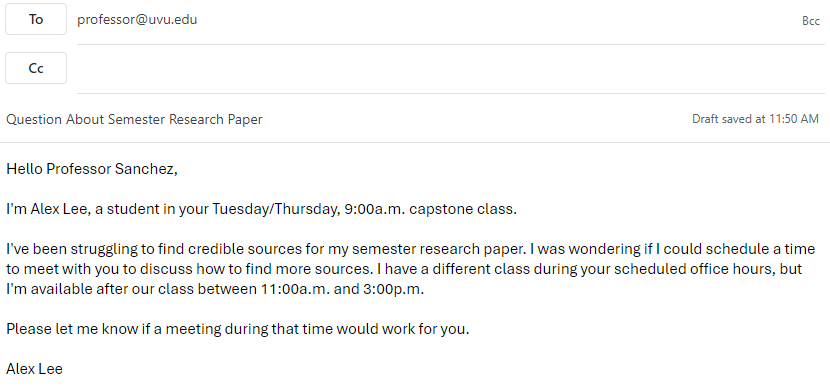Email is a common form of communication used at universities and in the workplace. Emails are often a more formal genre, particularly if your recipient is a professor, employer, coworker, or colleague. This handout covers general email concepts. However, always write with your audience and assignment in mind.
Identifying and writing to a specific audience will determine the formality of your tone, the level of detail, and the content of your email. When assessing your audience, consider the following questions:
The subject line identifies the purpose of the email and sets the tone for the entire message. This line should include a keyword or phrase that introduces the topic of the email. For example, when emailing a professor about a potential deadline extension for a midterm exam, Midterm Extension might be the subject line. Words in subject lines are capitalized.
The opening of an email is similar to the opening of a written letter. Typically, start by formally addressing the recipient. The opening will be different depending on your relationship with the recipient and the number of recipients. When possible, address the recipient by name and use the appropriate title.
The body of your email should be brief and direct and written with a clear purpose or request. When composing an email message, consider the following:
In closing your email, always state your name, and depending on the purpose of the message, add your position, company name, or additional contact information. Consider adding a friendly closing such as:
When replying to an email, remember that there are two options: Reply, which will reply only to the sender, and Reply All, which will reply to the sender and any other recipients included on the original email.
Emails are useful for sending files, including documents, pictures, and other media files. You can attach files or link directly to them. Your email service may limit file size, so it is best to attach smaller files. Clearly name your files and add a note in your message directing your recipient to any links or attachments. If needed, introduce the file and its purpose.

Email text:
Hello Professor Sanchez,
I'm Alex Lee, a student in your Tuesday/Thursday, 9:00a.m. capstone class.
I've been struggling to find credible sources for my semester research paper. I was wondering if I could schedule a time to meet with you to discuss how to find more sources. I have a different class during your scheduled office hours, but I'm available after our class between 11:00a.m. and 3:00p.m.
Please let me know if a meeting during that time would work for you.
Alex Lee